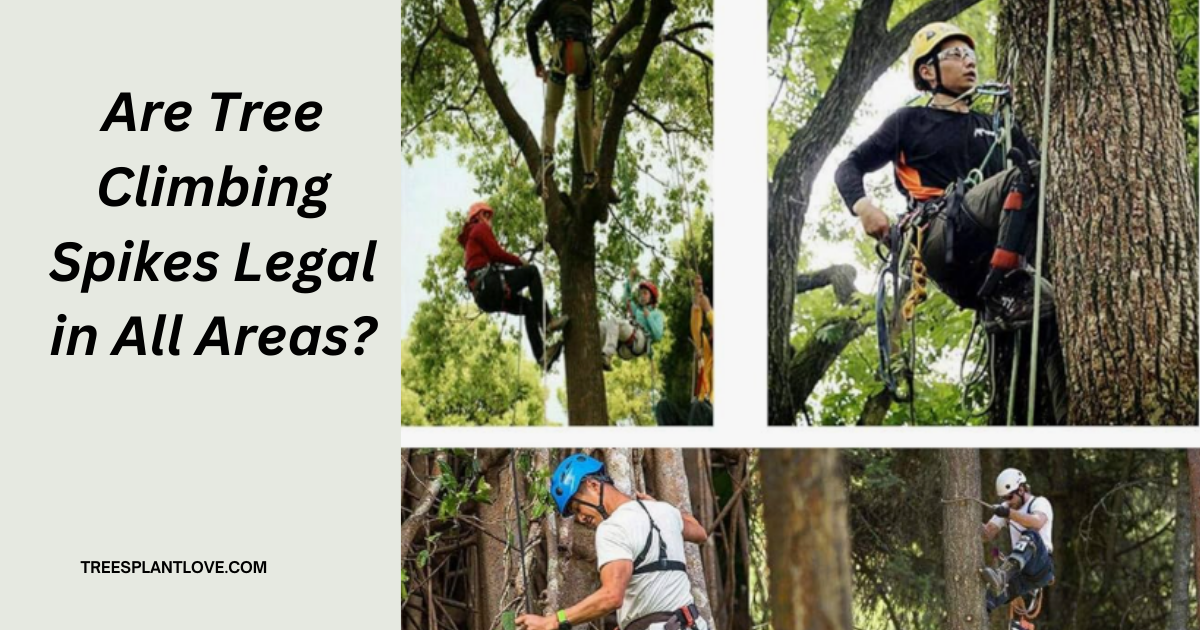
Are Tree Climbing Spikes Legal in All Areas? Know the Restrictions and Regulations
Are Tree Climbing Spikes Legal in All Areas?: Tree climbing spikes, also known as arborist spikes, are essential tools for many professionals in the tree care industry. They allow climbers to safely ascend trees, making it easier to prune, remove, or assess their health. However, while they are widely used, the legality of tree climbing spikes is not the same everywhere.
In fact, in certain regions and under specific circumstances, the use of climbing spikes may be restricted or even prohibited. This article explores the legal considerations surrounding tree climbing spikes and helps clarify where and when their use may be an issue.
Understanding Tree Climbing Spikes
Tree climbing spikesare sharp metal tools that are strapped to a climber’s legs and embedded into the trunk of a tree. The spikes provide the necessary grip for the climber to ascend with ease. Arborists use these spikes when performing tree work that requires ascending large trees, especially when no other climbing equipment can offer sufficient support.
Are Tree Climbing Spikes Legal?
The legality of tree climbing spikes largely depends on local laws, environmental regulations, and the specific purpose for which they are being used. Here are some factors to consider when evaluating the legality of these tools:
Environmental Protection Laws
One of the primary concerns regarding tree climbing spikes is the potential damage they cause to trees. When spikes are driven into a tree, they leave permanent scars that can lead to infections, rot, or even the tree’s death. This is particularly concerning when spikes are used on protected species or in sensitive ecosystems.
In many places, tree preservation laws, such as those in conservation areas or national parks, prohibit the use of tree climbing spikes because of the long-term damage they can inflict on trees. Local ordinances and regulations are designed to protect certain species of trees, and using spikes on these trees may be illegal.
Private Property vs. Public Land
On private property, the use of tree climbing spikes is generally allowed, provided the climber has the landowner’s permission. However, for public lands or protected forests, the rules are much stricter. Many local governments and federal agencies, like the U.S. Forest Service, restrict or outright ban the use of spikes on public trees to protect their health and prevent unnecessary damage.
For example, in national parks or protected wildlife areas, climbing spikes might be prohibited as they can harm the trees, particularly mature or rare species. Some authorities may instead require the use of alternative climbing methods that don’t leave permanent damage, such as rope systems or harnesses designed for more eco-friendly tree climbing.
Professional Regulations
Arborists and tree care professionals are often subject to industry regulations, which may include guidelines about the use of tree climbing spikes. Organizations like the International Society of Arboriculture (ISA) and other professional arborist bodies may advise or restrict the use of spikes during certain tree care tasks to minimize damage to trees.
In some cases, certified arborists may be required to demonstrate competency in using environmentally safe climbing techniques, which could mean limiting the use of spikes in favor of rope-based climbing methods or other less invasive tools. The goal of these regulations is to ensure that tree care is performed responsibly, with an eye toward sustainability and the preservation of tree health.
Situational Use
Tree climbing spikes are often allowed in situations where their use is justified by safety or practical considerations. For example, in situations where a tree has already been marked for removal or is severely damaged, using climbing spikes to secure a climber for cutting or pruning may be acceptable.
However, their use is discouraged or prohibited in cases where the tree is healthy and protected, as there is a higher risk of injury or long-term damage. Many arborists and tree climbers prefer to use rope climbing methods in these cases, as they are safer for the tree and do not cause the same permanent harm that spikes do.
Legal Alternatives to Tree Climbing Spikes
In areas where the use of climbing spikes is restricted or prohibited, climbers and arborists have a few legal and environmentally friendly alternatives. These include:
- Rope Climbing Systems: These methods utilize a variety of ropes, harnesses, and other climbing gear to ascend trees without causing damage. A popular option is the SRT (Single Rope Technique) or DRT (Double Rope Technique), which allows climbers to ascend using ropes tied around the tree trunk.
- Climbing Without Spikes: Many climbers rely solely on their climbing techniques and body strength, using safety ropes and ascenders to scale trees in a way that avoids the need for spikes altogether.
- Tree Climbing Saddles and Gear: Other equipment, such as climbing saddles, allows climbers to securely ascend trees with minimal risk of damaging them.
Conclusion
While tree climbing spikes are an essential tool for many professional arborists and tree climbers, their legality can vary significantly depending on the location and purpose of use. In areas with strict environmental protections or on public lands, using climbing spikes is often prohibited due to the potential harm they cause to trees.
Climbers should always check local laws and regulations before using tree climbing spikes and be prepared to switch to more eco-friendly alternatives when necessary.
Ultimately, the goal of any tree climbing operation should be to ensure the safety of the climber while preserving the health of the tree. By understanding the legal landscape and following industry best practices, climbers can enjoy their craft responsibly and sustainably.

Leave a Reply